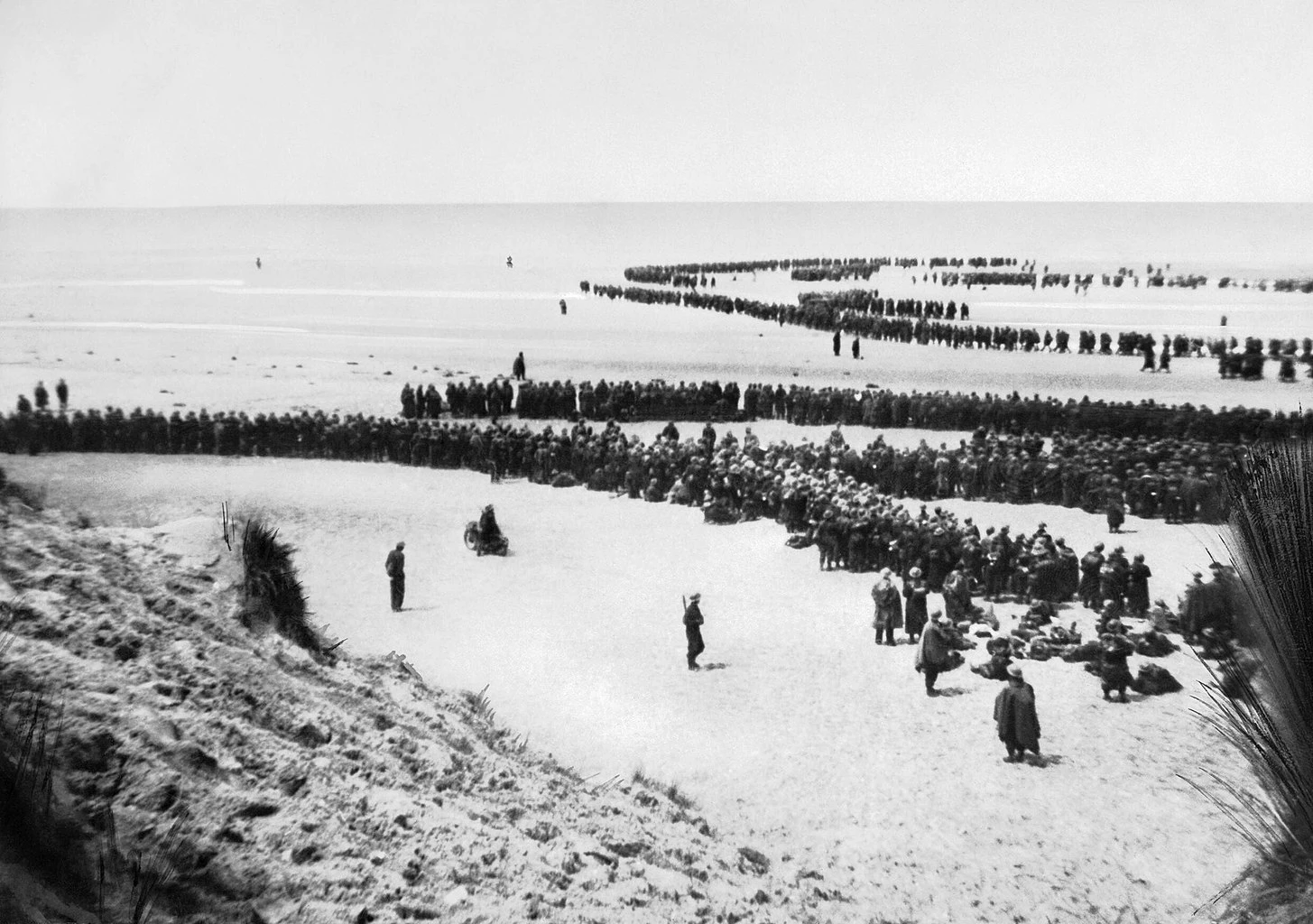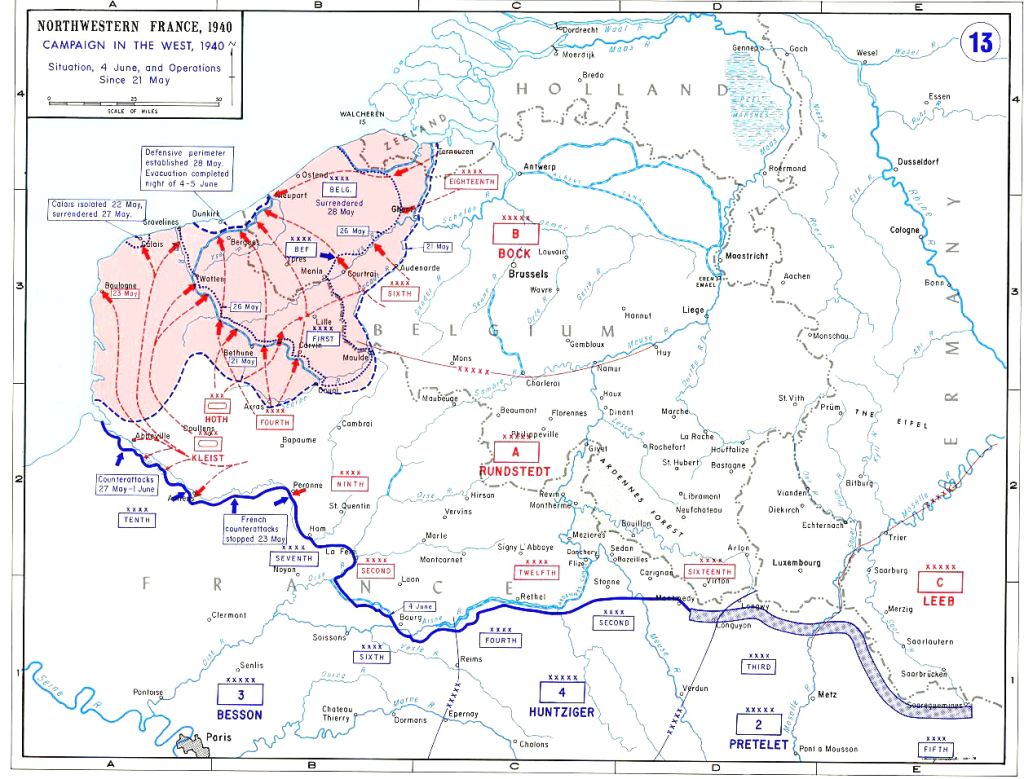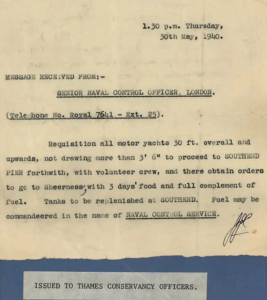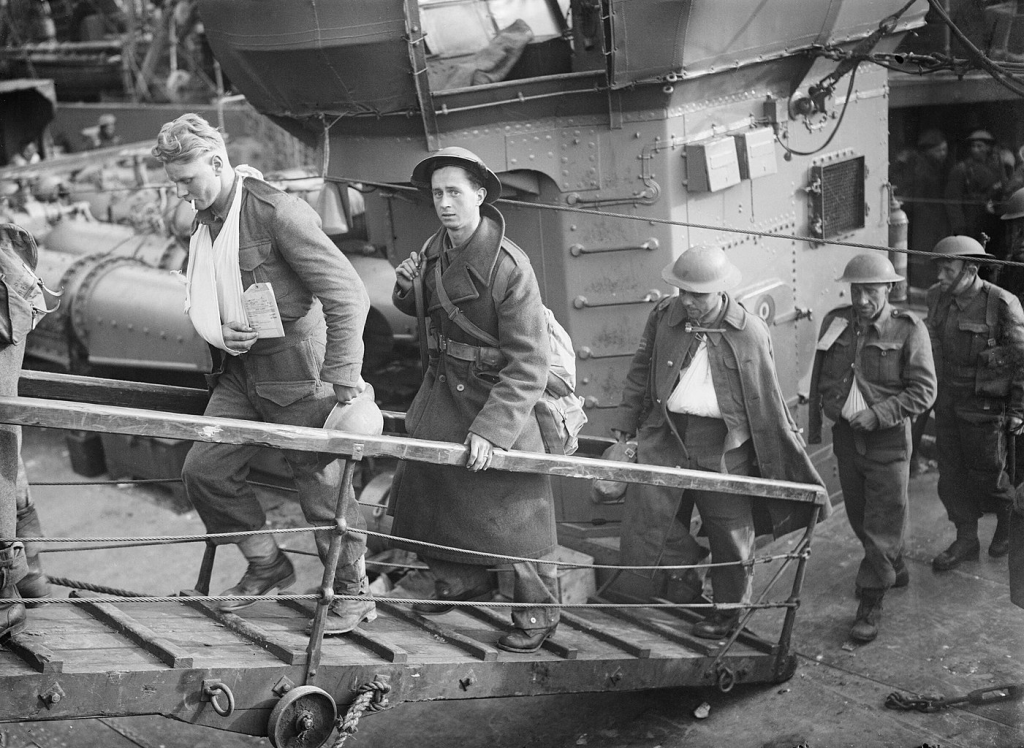
Operation Dynamo 26th-4th June 1940
DUNKIRK
The name alone is synonymous with courage in the face of overwhelming odds.
On 10th May 1940 - the day Churchill became Prime Minister - Germany invaded France and the Low countries. As the Germans cut through in a pincer movement (the Manstein Plan), the British Expeditionary Force (BEF) along with French and Belgian troops became surrounded by German troops in a bottleneck sixty miles deep and fifteen miles wide with the fierce onslaught of the Luftwaffe from above. Lord Gort Commander in Chief of the BEF wrote to Anthony Eden stating that "a great part of the BEF and its equipment will be lost in the best of circumstance." Things were dire. The Germans called upon the British to surrender "Your troops are entirely surrounded - Stop fighting ! Put down your arms! " it said on the leaflets they dropped from the sky alongside the bombs.. As the Allies pulled back they had destroyed their stores and disabled their equipment whilst the German airforce supporting the German artillery fired bombs into Dunkirk itself trapping the soldiers on the shallow beaches of the coast.

On 19th May Winston Churchill spoke to the British people "It would be foolish to deny the gravity of the hour". On 25th May the War Office decided to evacuate British troops in an operation named Dynamo.The call had gone out from the Admiralty both over the radio and flashing up in cinemas that anyone with seafaring experience should report to Ramsgate at once and many hundreds answered the call.
The BBC issued the following announcement on May 14th 1940:
"The Admiralty have made an order requesting all owners of self--propelled pleasure craft between 30 foot and 100 foot in length to send all particulars to the Admiralty within fourteen days of today if they have not already been offered or requisitioned"
In the tunnels below Dover Castle head of operations Vice Admiral Bertram Ramsay had begun planning by 14th May calling upon small boats with a shallow draft that could get in close to the beaches to pick soldiers up and ferry them out to waiting vessels offshore. Small boats including pleasurecraft were taken from wherever they could be found sometimes without the owners permission.

On 27th May Ramsay ordered Captain William Tennant now Senior Naval Officer to preside over the rescue from Dunkirk on the French side. He sailed across on HMS Wolfhound with twelve officers and 160 ratings dodging Nazi dive bombers on the way over.On arrival Tennant immediately saw that the beaches to the east of the town and the East Mole (seawall) would provide the best opportunity for evacuation. The expectation was that they might rescue 30,000 men from the carnage. Tennant sent message back to Ramsay ordering as many small boats as possible to Dunkirk.

There were three crossing routes X, Y and Z of which the shortest was Z at 39 nautical miles which hugged the French coast but left boats at the mercy of on shore batteries during the daytime hours. Route X travelled through a heavily mined portion of the Channel and was 55 nautical miles but could not be used at night. Route Y was 87 nautical miles but boats were susceptible to Luftwaffe attack and German surface warships. But in the event on 28th May 1940 well over 850 boats with motley crews from fishermen to private owners, lifeboatmen to trainee Naval reservists, bargees and some who had never been further than the English coast before answered the call to rescue their comrades some sailing through the night to reach the French coast. Among the first to cross the sixty miles of Channel was the 180 foot Medway Queen. A former pleasure cruiser more used to short Thames cruises she could carry a thousand passengers. Her crew worked tirelessly night and day for seven out of the eight nights contending with the funnel catching fire as well as leaving a phosphorescent trail that was ingeniously broken up with oil bags. At the other end of the scale was the Tamzine, a fishing boat less than 15 feet in length and now preserved by the Imperial War Museum. All had their part to play. The RAF provided air supremacy for the Royal Navy. On the first day only 7,669 soldiers were rescued but over the ensuing 9 days up to 4th June over 338,000 men were evacuated with some small boats returning to Ramsgate with their human cargo and then going straight back time and time again.

The RAF flew nearly four thousand sorties in support of Operation Dynamo engaging the Luftwaffe at every turn. On 28th May King Leopold of Belgium surrendered to Germany intensifying the pressure of the evacuation. Churchill warned the country to "prepare for the worst" but by late evening 11.30pm 3rd June 1940 after checking there were no British soldiers left Captain Tennant radioed Admiral Ramsey with the following " BEF evacuated, Operation completed. Returning to Dover". What became known as the Miracle of Dunkirk passed into national consciousness as the triumph of ordinary people who in the face of extreme danger had faced down evil and done something quite extraordinary to rescue their fellow men.
The following provide more information about events:
The Association of Dunkirk Little Ships (http:/www.adls.org.uk)
WW2 Talk (http:;/ww2talk.com)
Admiral Sir Bertram Ramsey (https://www.dday-overlord.com/battle-of normandy/biographies/gb/bertram-ramsay
Sir William George Tennant Architect of Dunkirk or "Dunkirk Joe" Wikipediahttps://en.wikipedia.org/wiki/William_Tennant_(Royal_Navy_officer)
Imperial War Museum (https:/www.iwm.org.uk)
Royal Museums Greenwich (https://www.rmg.co.uk/)
Dunkirk (2017) film by Christopher Nolan (https://en.wikipedia.org/wiki/Dunkirk_(2017_film)
Dunkirk (1958) film by Leslie Norman (https://www.imdb.com/title/tt0051565/)
Pathe newsreels (www.britishpathe.com)
the secondworldwar.org (https://www.thesecondworldwar.org/western-front-1939-1940/operation-dynamo/the-mole)
Your story starts here.
Submit your details on the corresponding form and one of us will get back to you to find out more about your requirements.

